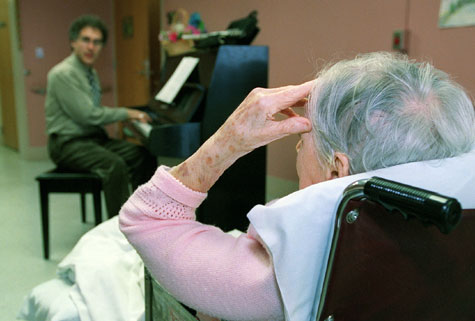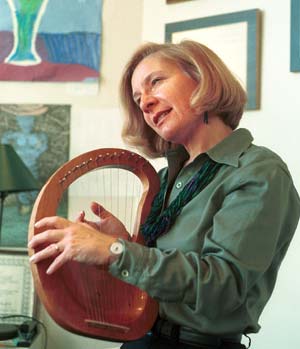Treating ills with music

She was the only one to survive the horrible car crash that killed her parents and siblings. The teenager was inconsolable. Shipped from her home in Oregon to the East Coast to live with an uncle, she suffered from depression and thoughts of suicide.
Annie (not her real name) was enrolled in a special high school at McLean Hospital, a private psychiatric facility in Belmont, Mass., affiliated with Harvard Medical School. Here, she showed a liking for music, particularly songs with lyrics she felt had a personal meaning for her. Always interested in the guitar, she began playing the songs that affected her most.
“It was a way for her to climb out of her personal sorrow and to reconnect with other kids her age,” says Fred Silverstone, a McLean music therapist. Along with psycho (talk) therapy and relaxation techniques, the combination brought her back into the social world and enabled her to think about her lost family with less pain and sorrow.”
No one can tell you how music therapy works. But there is overwhelming evidence that it does. The Web site of the American Music Therapy Association lists 57 pages of research articles published in its Journal of Music Therapy and other publications. The articles chronicle successful use of music, in combination with other therapies, to treat Alzheimer’s and Parkinson’s diseases, depression, anxiety, chronic pain, pain of childbirth, autism, and other physical and mental problems including substance abuse.
In none of these journal articles and pundit plaudits, however, can you find an answer to the question, “How does it work?”
The power of placebo, the ability of a treatment to work if a patient believes it will work, certainly is a factor, Silverstone notes. “But it doesn’t account for everything that we see,” he adds.
When a patient listens to music while his or her brain is being imaged with magnetic resonance imaging, many areas of the brain are affected that are not affected when not listening to music. That kind of result is still more qualitative than quantitative; it’s not hard science. However, as more and more such studies are done, Silverstone believes, “our result should reveal exactly what brain areas are affected and the specific connections between brain cells that change.”
More than placebo

Suzanne Hanser, now chair of the Music Therapy Department at Berklee College of Music in Boston, did an experiment demonstrating that people suffering from a combination of severe depression and high anxiety can do better when music is included in their treatment. Ten patients were visited at home by a therapist who used music to help them relax their minds and bodies. Ten more were coached by phone to develop their own program. Ten others received no music therapy as part of their treatment and served as comparison subjects.
“The result clearly showed that people being treated for depression and anxiety are helped by music,” says Hanser. “The benefit lasted not just for a day or two, but for at least nine months, according to the results of a follow-up study.”
Hanser did this research six years ago at Stanford University Medical Center in California. She adapted the same techniques to a new program created in June to help cancer patients at two hospitals in Boston affiliated with Harvard Medical School, Brigham and Women’s Hospital and the Dana-Farber Cancer Institute.
A former president of the American Music Therapy Association, Hanser is now secretary-treasurer of the World Federation of Music Therapy. She’s not sure we’ll ever know the scientific details of how music eases mental and physical ills.
“It’s not limited to one part of the brain as we used to believe,” Hanser maintains. “Rhythm is visceral; it affects our autonomic nervous system [the same system that controls breathing without our being aware of it]. Add in cultural influences, our private emotions, and personal memories and you have an effect too complex to analyze with current technology.”
Playing to Alzheimer’s
Oliver Sacks, the best-selling author and neurologist, has commented that patients with nervous system disorders who cannot talk or move are often able to sing, and even dance, to music. “I regard music therapy as a tool of great power in many neurological disorders [like] Parkinson’s and Alzheimer’s, because of its unique capacity to organize and reorganize [brain] function when it has been damaged,” he says.
Oldsters who suffer brain damage from Alzheimer’s can still respond to music. “It touches those parts of the brain that are uninjured, and can help Alzheimer’s patients communicate with others and lead a more social life,” Silverstone says. Hanser agrees. “People who are not even aware of their own names or of their family and friends will sometimes respond to music,” she notes. “People who can’t put two words together may be able to sing songs associated with birthdays, weddings, and other important events from their past. They not only understand the music; they may even hum a tune or play part of it on a simple instrument like a drum.”
Grief and pain
Most therapists can tell you stories about how music helps people manage grief and pain.
Silverstone cites the case of a man trying to overcome grief for his dead wife. Working with a psychologist, Silverstone had the man reminisce about the songs he and his wife once enjoyed. Then Silverstone encouraged the man to sing these songs. That helped him talk about his loss without feeling so sad. After a month of three to four music sessions a week, together with talk therapy, the man got his obsessive grief under control. He became able to think about the loss of his wife in less painful and more normal ways.
Music is used successfully for management of all kinds of pain, ranging from natural childbirth and dental work to unrelenting discomfort from injuries or disease. “We employ mental imagery to distract people from physical pain and the mental stress that accompanies it,” Hanser explains. “While playing on a lyre or other instrument, I tell a person to close their eyes and focus on an image that the music brings to them, trees swaying in a breeze, waves coming quietly to a beach, rain falling gently. Music can get people out of a painful body, and let them focus emotionally on more pleasant, positive things.”
“For chronic pain, singing or playing an instrument can help as much as listening,” Silverstone adds. “Almost anyone can play simple instruments like drums or xylophone with a little training. Singing provides further distraction. Stretching and dancing moves stiff muscles, particularly in people with Parkinson’s disease.”
What tunes to play
Almost any music will do. “Everyone likes to listen to some type of music – classical or country, rhythm and blues or rock and roll – so we play whatever a patient enjoys,” Silverstone notes.
“We play the music that has meaning for the patient,” Hanser adds. “All people find some kind of music that relaxes them, gives them pleasure, or takes their minds from obsessive thought and negative feelings.”
Of course, music plays two ways; it can bring out anxiety and anger. “But that’s not all bad.” Silverstone notes. “Such music can lead people to express feelings they may otherwise find too difficult to talk about. “It’s a path to verbal expression of what’s bothering them, and that makes it easier for therapists to help them deal with negative feelings.”
Hanser notes that she and her colleagues often use music to prepare patients for psychotherapy, as well as for medical procedures such as chemotherapy.
The music therapy department at Berklee College boasts 55 majors. It is one of more than 70 such degree programs in the United States, according to the American Music Therapy Association. Those who graduate become eligible to work in places such as hospitals, rehabilitation facilities, senior and adult day care centers, hospices, drug and alcohol programs, and schools.
In some cases, music therapy can be covered, at least partially, by medical insurance.
Those interested in more information on the subject can log on to http://www.musictherapy.org/.




